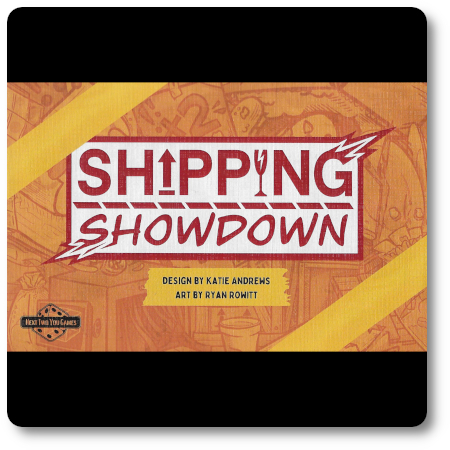 The Basics:
The Basics:
- For ages 10 and up (publisher suggests 12+)
- For 2 players
- Approximately 30 minutes to complete
Geek Skills:
- Active Listening & Communication
- Counting & Math
- Logical & Critical Decision Making
- Reading
- Strategy & Tactics
- Hand/Resource Management
Learning Curve:
- Child – Easy
- Adult – Easy
Theme & Narrative:
- Jump on the line and pack those boxes as fast as you can to make your quota!
Endorsements:
- Gamer Geek rejected!
- Parent Geek mixed!
- Child Geek approved!
Overview
Jamaican-Canadian billionaire businessman and philanthropist, Michael Lee-Chin, said “My first playpen was a cardboard box.” I have many fond memories of playing in cardboard boxes myself. Making them into forts or using them to build a robot (that I might have also worn as a costume). But those boxes serve the initial purpose of holding things. In this game, you’ll be tasked to fill boxes full of items as quickly as you can. Fill it up and send it out! Just be careful that your fellow box-packers don’t upset your productivity!
Shipping Showdown, designed by Katie Andrews and published by Next Two You Games, is comprised of 15 Item cards, 20 Action cards, and 77 Material cards. The cards are thick and slightly more durable than your standard playing card. The illustrations, by artist Ryan Rowitt, on the cards are colorful and do a great job of representing the various “stuff” the players will be looking to pack in boxes as quickly as possible.
Packing Boxes
Shipping Showdown comes with two different variants of gameplay. Consequently, the game setup is slightly different based on which of the two variants are selected. Regardless, however, the setup always includes shuffling the three different card types and dealing out a certain number either to the table or to the players.
Game Variant One
The first of the game variants places five random Item cards in front of both players. The Item cards are visible to both, but each player only uses the five Item cards in front of them. Three Action cards are also dealt to the table and made visible to both players with the remainder set aside by the Item deck. The only cards to remain hidden from the opponent are the Material cards which are kept in the players’ hands.
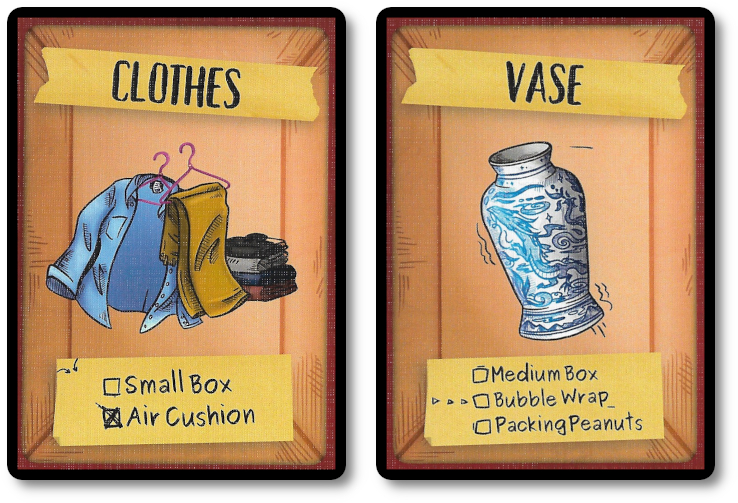
On the player’s turn, they will draw up to five Material cards to fill their hand and then play up to two Material cards to any of the visible Item cards that they own. The one exception is if the player wants to play a Material card with an action symbol, which gives the player a special option of activating any of the currently three visible Action cards, but costs them the ability to play a second Material card. After playing the Material and Action cards, the player then “sends” any completed Item cards by picking up the Item card and all attached Material cards, keeping all cards face-up. An Item card is considered “complete” once all of the noted Materials are attached. Finally, the player discards any Material cards in their hand, ending their turn.
The game comes to an end when either player clears all the Items they own, sending them off to destinations unknown.
Game Variant Two
The second of the game variants will only require both players to draw one Item card each, putting it in front of them with the remaining set off to one side. Two Action cards are drawn and set aside, as well, for both players to use during the game. Each player will draw three Material cards for their starting hand.
On the player’s turn, they will draw up to three Material cards. From their hand, the player can now play all three Material cards to their Item cards if none have an action symbol. If the player does play a Material card with an action symbol, they may play two for their action or just one for its action and any other Material card that does not have an action. Optionally, if the Item cards in front of the player do not require any Material cards the player has in their hand, they may discard and draw new Material cards.
If the player completes the requirements for their Item card, they “send” it off and move it to one side of the game-playing area for them to keep. Then the player discards any number of cards from their hand they like. Finally, if the player did successfully send their Item card, they draw a new one and place it in front of them to work on during their next turn.
The game ends when the first player has successfully sent off six Item cards.
Quick Word on Those Actions and Materials
While the focus of the game is completing the requirements of Item cards as quickly as possible, the real “meat” of the game is in the actions provided by the Action cards. Here the player can manipulate Items, Materials, and even opponent turns and completed Items they have sent. For the most part, the Action cards are all very obvious about how they operate and should be used. A handy reference is provided in the game rules that will help clarify any ambiguity, which we found very little.
Material cards are very straightforward with one exception. Included with the Material cards are three cards that do not operate as other Material cards. These are the “Vendor Delivery,” “Item Found,” and “Wildcard” Material cards.
The “Vendor Delivery” Material card counters the “Out of Stock” Action card. Play the “Vendor Delivery” Material card to discard it and the “Out of Stock” Action card.
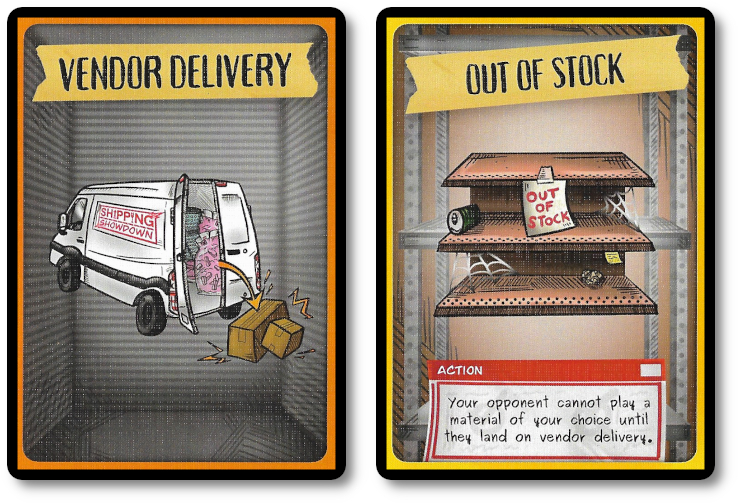
The “Item Found” Material card counters the “Item Lost” Action card. Play the “Item Found” Material card to return an incomplete Item card back into play.
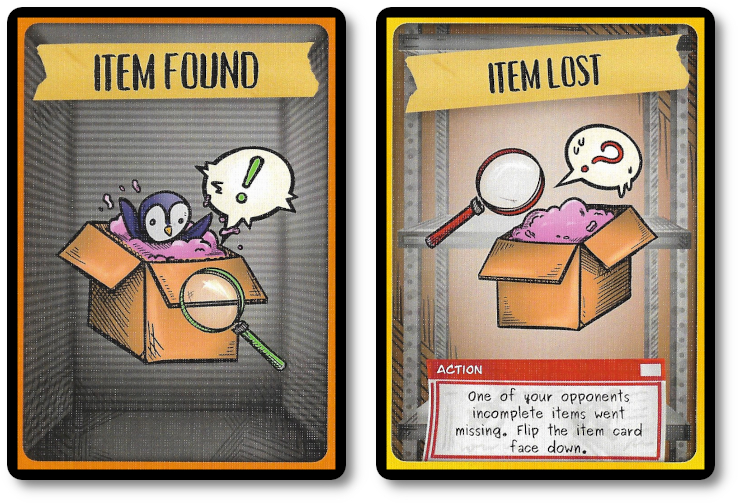
The “Wildcard” Material card can represent any other Material card, however, it does not provide the possibility of an action.
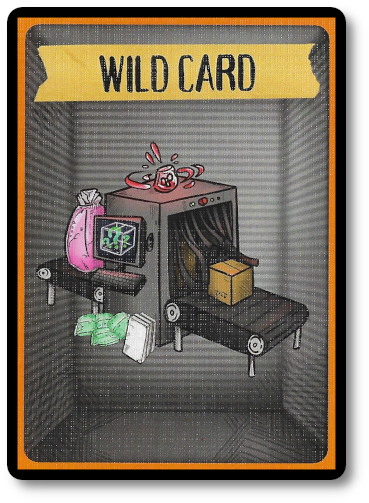
To learn more about Shipping Showdown, visit the game publisher’s website.
Final Word
 The Child Geeks had a great deal of fun with the game with the predicted level of disappointment and sheer evil glee when the cards were manipulated to their benefit or detriment. It’s important to note that this is not a difficult game to teach or to play, but the gameplay itself does allow an opponent to sabotage a player’s progress with ease. For those Child Geeks who are still learning that an upset game piece if not a personal attack, expect a few tears and mounting frustration. One Child Geek said, “I liked the game and found it to be pretty fast. I didn’t like it when my brother messed with my stuff, but I did mess with his so I guess it is only fair.” Another Child Geek said, “I like both versions of the game and I think I like the one with more items to work on more.” When the last item was packed, labeled, and shipped the Child Geeks took a vote and decided that Shipping Showdown delivered on the fun.
The Child Geeks had a great deal of fun with the game with the predicted level of disappointment and sheer evil glee when the cards were manipulated to their benefit or detriment. It’s important to note that this is not a difficult game to teach or to play, but the gameplay itself does allow an opponent to sabotage a player’s progress with ease. For those Child Geeks who are still learning that an upset game piece if not a personal attack, expect a few tears and mounting frustration. One Child Geek said, “I liked the game and found it to be pretty fast. I didn’t like it when my brother messed with my stuff, but I did mess with his so I guess it is only fair.” Another Child Geek said, “I like both versions of the game and I think I like the one with more items to work on more.” When the last item was packed, labeled, and shipped the Child Geeks took a vote and decided that Shipping Showdown delivered on the fun.
 The Parent Geeks found the game to be entertaining, but not altogether engaging to a point where it was the same level of “fun” with their peers. Where the game shined was playing it against their children. According to one Parent Geek, “I think the game is simple enough to learn and teach, as well as having enough interesting decisions to make as an adult. I didn’t much care for it, however, with my husband. I did enjoy it a great deal with my kids!” Another Parent Geek said, “A bit too casual and straightforward for me. I played it a few times and realized each game was more or less the same with little surprises. Perfect game to play with my children based on that alone. We had a great time competing against each other.” When the warehouse closed for the day, the Parent Geeks evaluated the game’s performance and gave it a mixed endorsement. Great for the family with kids, but not a lot of entertainment with just the adult crowd.
The Parent Geeks found the game to be entertaining, but not altogether engaging to a point where it was the same level of “fun” with their peers. Where the game shined was playing it against their children. According to one Parent Geek, “I think the game is simple enough to learn and teach, as well as having enough interesting decisions to make as an adult. I didn’t much care for it, however, with my husband. I did enjoy it a great deal with my kids!” Another Parent Geek said, “A bit too casual and straightforward for me. I played it a few times and realized each game was more or less the same with little surprises. Perfect game to play with my children based on that alone. We had a great time competing against each other.” When the warehouse closed for the day, the Parent Geeks evaluated the game’s performance and gave it a mixed endorsement. Great for the family with kids, but not a lot of entertainment with just the adult crowd.
 The Gamer Geeks played the game a few times and decided fairly quickly to give it a pass going forward. According to one Gamer Geek, “Not a bad game. Just not a game for me. Decisions are obvious, gameplay is redundant, and outcomes are always subject to random card plays. A bit frustrating at times and a bit devious at others. Never really found its footing with me and was over before I had much in the way of an opinion. Then again, some of the other games took too long.” Another Gamer Geek said, “A great game for the family or the kids. Not for me or my friends who like games with more strategy and tactics. I would suggest this game to anyone who is just now getting into the hobby.” When the last game was played and the cards put away, the Gamer Geeks decided to put the game back on the shelf and forget about it.
The Gamer Geeks played the game a few times and decided fairly quickly to give it a pass going forward. According to one Gamer Geek, “Not a bad game. Just not a game for me. Decisions are obvious, gameplay is redundant, and outcomes are always subject to random card plays. A bit frustrating at times and a bit devious at others. Never really found its footing with me and was over before I had much in the way of an opinion. Then again, some of the other games took too long.” Another Gamer Geek said, “A great game for the family or the kids. Not for me or my friends who like games with more strategy and tactics. I would suggest this game to anyone who is just now getting into the hobby.” When the last game was played and the cards put away, the Gamer Geeks decided to put the game back on the shelf and forget about it.
 If you play card, board, and dice games for any significant amount of time, you start to see the same game mechanics. Shipping Showdown makes use of time-honored and highly refined game mechanics as its backbone and the gameplay benefits from it. That said, anyone who has played games for a long period of time will be underwhelmed, as was the result reported by the Gamer Geeks. It’s important to note that this does not make Shipping Showdown a poorly designed game. Far from it. It does, however, make the game less appealing and engaging for the gamer veterans. A good point to remember if you are interested in putting the game in front of a mixed crowd.
If you play card, board, and dice games for any significant amount of time, you start to see the same game mechanics. Shipping Showdown makes use of time-honored and highly refined game mechanics as its backbone and the gameplay benefits from it. That said, anyone who has played games for a long period of time will be underwhelmed, as was the result reported by the Gamer Geeks. It’s important to note that this does not make Shipping Showdown a poorly designed game. Far from it. It does, however, make the game less appealing and engaging for the gamer veterans. A good point to remember if you are interested in putting the game in front of a mixed crowd.
My favorite aspect of the game was the feeling of accomplishment I received when I completed an Item card. This is especially true when an Item requires a large number of Material cards to complete. Some Item cards can take longer than a player might consider “necessary” due to not having the right Material cards in play. This makes discarding Material cards an essential part of the player’s turn. You gain nothing from holding Material cards you cannot use. Get comfortable discarding and discarding frequently.
The least favorite aspect of the game was how the game was won. You can get a few Item cards that require very little in the way to complete. This puts you at a great advantage of winning the game if your opponent is unlucky enough to be assigned several Item cards that require many Material cards to complete. This was noted a few times by our players, but eventually proved to be nothing more than a psychological issue rather than a gameplay issue. Since players have to complete a number of Item cards, a few here and there that can be completed fairly quickly did not upset the gameplay to a significant point where any one player felt cheated. I think a better approach would be awarding points based on the complexity of the item to be packed, but that’s just me.
Overall, I found Shipping Showdown to be a great card game to play with the kids and to introduce as a starting game to players of all ages who were not overly familiar with the hobby of board, card, and dice games. This makes Shipping Showdown a wonderful game to bring with you if you don’t know who you’ll be playing with or what their experience is. I would expect to see Shipping Showdown in brewery tap rooms or at libraries. For your own game collection, you’ll enjoy it but most likely move on fairly quickly to more complex games. Still, there are plenty of good reasons to give Shipping Showdown a try the first chance you get. Play it at your family gaming table to see if this game delivers the fun!
This game was given to Father Geek as a review copy. Father Geek was not paid, bribed, wined, dined, or threatened in vain hopes of influencing this review. Such is the statuesque and legendary integrity of Father Geek.



